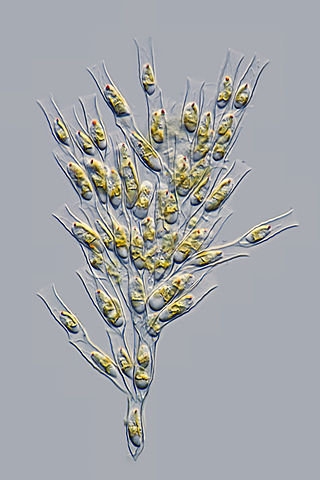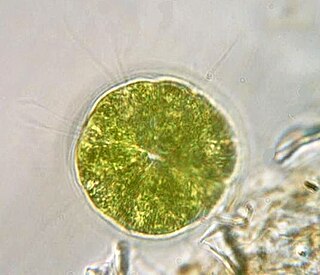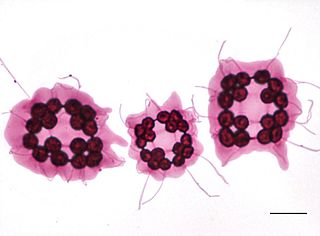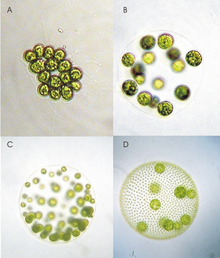
The Chlorophyceae are one of the classes of green algae, distinguished mainly on the basis of ultrastructural morphology. They are usually green due to the dominance of pigments chlorophyll a and chlorophyll b. The chloroplast may be discoid, plate-like, reticulate, cup-shaped, spiral- or ribbon-shaped in different species. Most of the members have one or more storage bodies called pyrenoids located in the chloroplast. Pyrenoids contain protein besides starch. Some green algae may store food in the form of oil droplets. They usually have a cell wall made up of an inner layer of cellulose and outer layer of pectose.

A flagellate is a cell or organism with one or more whip-like appendages called flagella. The word flagellate also describes a particular construction characteristic of many prokaryotes and eukaryotes and their means of motion. The term presently does not imply any specific relationship or classification of the organisms that possess flagella. However, the term "flagellate" is included in other terms which are more formally characterized.

Volvox is a polyphyletic genus of chlorophyte green algae in the family Volvocaceae. It forms spherical colonies of up to 50,000 cells. They live in a variety of freshwater habitats, and were first reported by Antonie van Leeuwenhoek in 1700. Volvox diverged from unicellular ancestors approximately 200 million years ago.

The Volvocaceae are a family of unicellular or colonial biflagellates, including the typical genus Volvox. The family was named by Ehrenberg in 1834, and is known in older classifications as the Volvocidae. All species are colonial and inhabit freshwater environments.

The glaucophytes, also known as glaucocystophytes or glaucocystids, are a small group of unicellular algae found in freshwater and moist terrestrial environments, less common today than they were during the Proterozoic. The stated number of species in the group varies from about 14 to 26. Together with the red algae (Rhodophyta) and the green algae plus land plants, they form the Archaeplastida. However, the relationships among the red algae, green algae and glaucophytes are unclear, in large part due to limited study of the glaucophytes.

The Chrysophyceae, usually called chrysophytes, chrysomonads, golden-brown algae or golden algae are a large group of algae, found mostly in freshwater. Golden algae is also commonly used to refer to a single species, Prymnesium parvum, which causes fish kills.

Pandorina is a genus of green algae composed of 8, 16, or sometimes 32 cells, held together at their bases to form a sack globular colony surrounded by mucilage. The cells are ovoid or slightly narrowed at one end to appear keystone- or pear-shaped. Each cell has two flagella with two contractile vacuoles at their base, an eyespot, and a large cup-shaped chloroplast with at least one pyrenoid.
Chlorococcales is a formerly recognized order of green algae in the class Chlorophyceae. As of February 2022, the type family Chlorococcaceae was placed in the order Chlamydomonadales.

The cryptophyceae are a class of algae, most of which have plastids. About 220 species are known, and they are common in freshwater, and also occur in marine and brackish habitats. Each cell is around 10–50 μm in size and flattened in shape, with an anterior groove or pocket. At the edge of the pocket there are typically two slightly unequal flagella.
In botany, a zoid or zoïd is a reproductive cell that possesses one or more flagella, and is capable of independent movement. Zoid can refer to either an asexually reproductive spore or a sexually reproductive gamete. In sexually reproductive gametes, zoids can be either male or female depending on the species. For example, some brown alga (Phaeophyceae) reproduce by producing multi-flagellated male and female gametes that recombine to form the diploid sporangia. Zoids are primarily found in some protists, diatoms, green alga, brown alga, non-vascular plants, and a few vascular plants. The most common classification group that produces zoids is the heterokonts or stramenopiles. These include green alga, brown alga, oomycetes, and some protists. The term is generally not used to describe motile, flagellated sperm found in animals. Zoid is also commonly confused for zooid which is a single organism that is part of a colonial animal.

Eustigmatophytes are a small group of eukaryotic forms of algae that includes marine, freshwater and soil-living species.

Gonium is a genus of colonial algae, a member of the order Chlamydomonadales. Typical colonies have 4 to 16 cells, all the same size, arranged in a flat plate, with no anterior-posterior differentiation. In a colony of 16 cells, four are in the center, and the other 12 are on the four sides, three each. A description by G.M. Smith :
Gonium Mueller 1773: Colonies of 4-8-16 cells arranged in a flat quadrangular plate and embedded in a common gelatinous matrix or connected by broad gelatinous strands. Cells ovoid to pyriform, with a single cup-shaped chloroplast containing one pyrenoid. Each cell with two cilia of equal length, contractile vacuoles at the base of the cilia, and an eyespot. Four- and eight-celled colonies with the cilia on the same side ; sixteen-celled colonies with the four central cells having their cilia on the same side and the twelve marginal cells with radially arranged cilia.
Asexual reproduction by simultaneous division of all cells in the colony to form autocolonies, or by a formation of 2-4 zoospores in each cell.
Sexual reproduction isogamous, by a fusion of biciliatezoogametes.

Chlamydomonadaceae is a family of algae within the order Chlamydomonadales.
Oocystaceae is a family of green algae, in the order Chlorellales. The type genus is Oocystis.
The Tetrasporaceae are a family of green algae, specifically of the Chlamydomonadales.
Astrephomene is a genus of green algae in the family Goniaceae, order Chlamydomonadales. The genus was first described in 1937 by Pocock and named by Pockock in 1953.

Pleodorina is a genus of colonial green algae in the family Volvocaceae. Description by Gilbert M. Smith.
Pleodorina Shaw 1894:
Colonies always motile; spherical to sub-spherical, with 32-128 cells lying some distance from one another just within the periphery of the homogeneous, hyaline, gelatinous, colonial envelope and not connected by cytoplasmic strands. Cells differentiated into those that are purely vegetative in character and those capable of dividing to form daughter colonies. All but four cells of the colony reproductive or about half reproductive and half vegetative. Cells spherical to ovoid in shape. Vegetative cells with a cup-shaped chloroplast containing one pyrenoid; a large anterior eyespot; two cilia of equal length with two contractile vacuoles at their base. Reproductive cells at first like the vegetative cells, later with a more massive chloroplast that eventually contains several pyrenoids. The eyespot and cilia of reproductive cells disappearing when they are mature.

Platydorina is a genus of microscopic green algae in the family Volvocaceae. It contains only one species, Platydorina caudata. It was described by Charles Atwood Kofoid in 1899.

Stephanosphaera is a genus of green algae in the family Haematococcaceae, containing the single species Stephanosphaera pluvialis. It forms colonies of flagellated cells. Although it was once placed in the family Volvocaceae, it is not closely related to them; its sister is the unicellular genus Balticola.

Goniaceae is a family of algae in the order Chlamydomonadales, that includes the genera Astrephomene and Gonium. Members of the Goniaceae are distinguished from those of the Volvocaceae by having each cell surrounded by a tripartite boundary of the extracellular matrix, as opposed to the entire colony being surrounded by the tripartite boundary in Volvocaceae.














